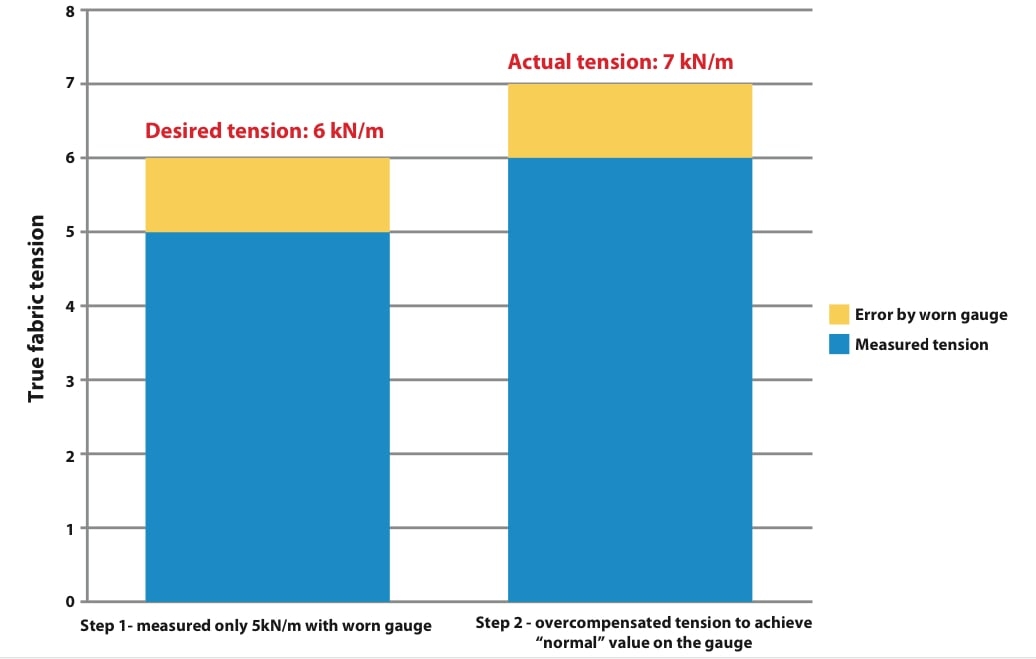
Features
Maintenance & Reliability
Signs of wear and tear
Jul. 20, 2017 - Almost every paper mill using forming fabrics has one — a mechanical tension gauge to measure the tension of paper machine clothing, mostly forming fabrics. When these instruments are not in perfect condition, they can cause serious problems, such as torn fabrics, too narrow and/or too long fabrics, and bearing failure.
July 20, 2017 By Marcel Lensvelt Feltest Equipment BV

Poorly maintained tension gauges may cause severe damages
Working principle
To understand the risks, it is important to understand how the mechanical tension gauges work. The working principle is shown in Image 1. The sensor bar at the bottom is pushed into the fabric by a pre-defined spring load. The amount of travel of the bar is converted through spindle and clockwork into a value on the dial. The higher the fabric tension, the more the bar is pushed upwards, causing the needle to rotate clockwise, indicating a higher value on the dial.
What happens when the devices get older?
After a certain period of use, the instrument will start showing signs of wear and tear. Mechanical wear of the sensor bar and a leaking bellow seal are the most common problems with older tension gauges and these two phenomena represent the highest risks.
Worn sensor bar
In many older tension gauges, the sensor bar is worn down for several millimetres, resulting in a flat contact surface compared to the original rounded bar.
Now remember the working principle of the gauge. In fact, the travel of the sensor bar is converted into a tension value.
In Image 2, a worn bar is compared to a new bar. The spring load is equal in both cases, and the fabric deformation will be practically the same with an old or worn sensor bar. However, Image 3 shows the worn sensor bar will travel further downwards than its new counterpart, resulting in different travel distances between the old and new sensor bar.
Leaking bellow seal
The tension gauges are used in a very wet environment and the splash water can be quite corrosive. Aging effects of the rubber material and the moving spindle will wear out the bellow, no longer making it watertight. When process water can enter the instruments interior, soon the bearings of the spindle will start corroding. This internal corrosion will give the spindle extra mechanical resistance during the measurement. In other words, with a certain amount of fabric tension, the sensor bar will not travel as easy upwards as it should.
Worn tension gauges give too low test results
In summary, the two most common defects on mechanical tension gauges are a worn sensor bar and a leaking bellow, causing internal friction. Both defects have the same effect on the measurements — the gauge will show tension values lower than what they really are. A worn sensor bar will move the spindle downwards and, hence, the needle moves counterclockwise towards lower values on the dial. More friction on the bearings makes the spindle “stick” when it should be moving up, again resulting in lower values on the dial.
What happens in daily practice
In many paper mills, the tension gauges are used as long as the needle is still moving — the accuracy is too often not questioned.
For every paper machine clothing position, the operators know the desired fabric tension, for example 6 kN/m. If the fabric tension is measured and the gauge shows 5 kN/m, the machine tension is increased until the gauge shows the desired 6 kN/m on its dial. However, due to the problems described above, the true fabric tension will then be clearly over the 6 kN/m mark.
When paper machine clothing runs at a higher than expected tension, a number of things can happen:
• the fabrics may stretch, finally running out of tension possibilities,
• the fabrics can become narrow,
• the dewatering behaviour of forming fabrics can change,
• the seam can be overloaded, resulting in torn fabrics, and
• the fabric guiding rolls cannot handle the extra tension, and a roll-bending or bearing failure may occur.
In conclusion
The negative effects of poorly maintained tension gauges are often underestimated. The summary of this article is clear — a regular service or timely replacement of this precision measuring instrument can prevent many costly problems and damages including production loss, bearing failure and increased clothing costs.
Marcel Lensvelt is managing director of Feltest Equipment BV, marcel.lensvelt@ feltest.com.
This article was previously published in the Summer 2017 issue of Pulp & Paper Canada.
Print this page